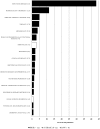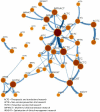Evaluating research and impact: a bibliometric analysis of research by the NIH/NIAID HIV/AIDS clinical trials networks
- PMID: 21394198
- PMCID: PMC3048860
- DOI: 10.1371/journal.pone.0017428
Evaluating research and impact: a bibliometric analysis of research by the NIH/NIAID HIV/AIDS clinical trials networks
Abstract
Evaluative bibliometrics uses advanced techniques to assess the impact of scholarly work in the context of other scientific work and usually compares the relative scientific contributions of research groups or institutions. Using publications from the National Institute of Allergy and Infectious Diseases (NIAID) HIV/AIDS extramural clinical trials networks, we assessed the presence, performance, and impact of papers published in 2006-2008. Through this approach, we sought to expand traditional bibliometric analyses beyond citation counts to include normative comparisons across journals and fields, visualization of co-authorship across the networks, and assess the inclusion of publications in reviews and syntheses. Specifically, we examined the research output of the networks in terms of the a) presence of papers in the scientific journal hierarchy ranked on the basis of journal influence measures, b) performance of publications on traditional bibliometric measures, and c) impact of publications in comparisons with similar publications worldwide, adjusted for journals and fields. We also examined collaboration and interdisciplinarity across the initiative, through network analysis and modeling of co-authorship patterns. Finally, we explored the uptake of network produced publications in research reviews and syntheses. Overall, the results suggest the networks are producing highly recognized work, engaging in extensive interdisciplinary collaborations, and having an impact across several areas of HIV-related science. The strengths and limitations of the approach for evaluation and monitoring research initiatives are discussed.
Conflict of interest statement
Figures
References
-
- National Institute of Allergy and Infectious Diseases, Division of Acquired Immunodeficiency Syndrome (DAIDS) website. Available: http://www.niaid.nih.gov/about/organization/daids/Networks/Pages/daidsne.... Accessed 2010 Sep 9.
-
- Small H, Greenlee E. A co-citation of AIDS research. Communication Research. 1989;16:642–66.
-
- Bierbaum EG, Brooks TA. The literature of Acquired Immunodeficiency Syndrome (AIDS): continuing changes in publication patterns and subject access. Journal of the American Society for Information Science. 1995;46:530–6.
-
- Sengupta IN, Kumari L. Bibliometric analysis of AIDS literature. Scientometrics. 1991;20:297–315.
Publication types
MeSH terms
Grants and funding
- U01AI068619/AI/NIAID NIH HHS/United States
- U01 AI068619/AI/NIAID NIH HHS/United States
- UL1 RR024996/RR/NCRR NIH HHS/United States
- U01AI068633/AI/NIAID NIH HHS/United States
- U01AI068641/AI/NIAID NIH HHS/United States
- U01 AI068636/AI/NIAID NIH HHS/United States
- U01AI068632/AI/NIAID NIH HHS/United States
- N01-AI-50022/AI/NIAID NIH HHS/United States
- UL1-RR-024996/RR/NCRR NIH HHS/United States
- U01AI068636/AI/NIAID NIH HHS/United States
- U01 AI068614/AI/NIAID NIH HHS/United States
- U01 AI068633/AI/NIAID NIH HHS/United States
- N01 AI050022/AI/NIAID NIH HHS/United States
- U01 AI068632/AI/NIAID NIH HHS/United States
- U01 AI068641/AI/NIAID NIH HHS/United States
LinkOut - more resources
Full Text Sources
Medical



